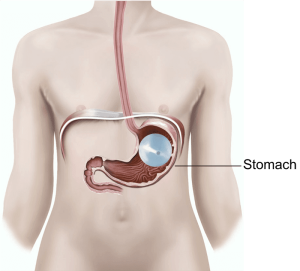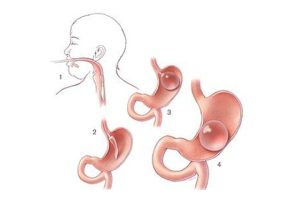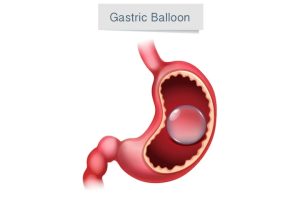Unveiling the Gastric Balloon: The Future of Effective Weight Management
Table of Contents

Introduction
The global obesity epidemic has reached alarming proportions, necessitating the development of effective weight management strategies. While traditional methods such as diet and exercise remain cornerstones of weight loss, they often fail to deliver sustainable results for individuals struggling with severe obesity. In recent years, a novel approach known as the gastric balloon has emerged as a promising solution for effective weight management.
The gastric balloon is a non-surgical, minimally invasive intervention that involves placing a deflated balloon in the stomach to promote feelings of fullness and reduce food intake. As the balloon occupies space within the stomach, it limits its capacity, leading to decreased appetite and portion control. This technique facilitates weight loss and encourages individuals to adopt healthier eating habits and long-term lifestyle changes.
Types of gastric balloons
Several types of gastric balloons are available, varying in design, materials, and insertion methods. Clinical studies have demonstrated the efficacy of gastric balloons in achieving significant weight loss, reducing comorbidities associated with obesity, and improving overall quality of life. However, it is essential to note that the gastric balloon is not a standalone solution but a tool that works best when coupled with comprehensive weight management programs involving dietary modifications, exercise, and behavioural counselling.
While the current generation of gastric balloons has shown promising results, ongoing research and technological advancements are paving the way for the future of this approach. This article aims to delve into the various aspects of the gastric balloon, including its procedure, efficacy, advantages, and potential future developments. By unravelling the potential of the gastric balloon, we can gain valuable insights into the future of effective weight management strategies.
Understanding the Gastric Balloon
The gastric balloon is a medical device designed to aid in weight loss by occupying space within the stomach and inducing feelings of fullness. Understanding the mechanism of action and the different types of gastric balloons is crucial to appreciate their potential for effective weight management.
Definition and Purpose of a Gastric Balloon:
A gastric balloon is a temporary, inflatable device placed in the stomach to reduce its capacity and promote weight loss. The purpose of the gastric balloon is to limit food intake, create a sensation of fullness, and encourage portion control. By occupying space within the stomach, the balloon restricts the volume of food consumed, leading to reduced calorie intake and subsequent weight loss (1).
How the Gastric Balloon Works:
The gastric balloon works by physically reducing the available space in the stomach. The deflated balloon is inserted endoscopically through the mouth and oesophagus and then filled with a sterile solution, such as saline or air. Once inflated, the balloon floats freely in the stomach, exerting pressure on its walls. This pressure contributes to early satiety, decreased hunger, and increased feelings of fullness (2).
Different Types of Gastric Balloons Available:
Several types of gastric balloons are available, differing in design, materials, and insertion methods. Some balloons are filled with saline, while others are filled with air. Additionally, some balloons are designed to be adjustable, allowing for volume modifications during the treatment period. Examples of gastric balloons include the BioEnterics Intragastric Balloon (BIB®), the Orbera® Intragastric Balloon, and the Spatz3 Adjustable Balloon (3).
Benefits of the Gastric Balloon Approach:
The gastric balloon approach offers several advantages for weight management. It is a minimally invasive procedure, meaning it does not require surgery and involves a shorter recovery time than surgical interventions. Furthermore, the gastric balloon is reversible and temporary, allowing individuals to evaluate their response to the treatment before committing to long-term weight loss strategies. It also serves as a tool to initiate lifestyle changes, as patients are often provided nutritional counselling and support throughout treatment (4).
Understanding the gastric balloon, its mechanism of action, and the available types provides a foundation for comprehending its potential as an effective weight management tool. The following section will delve into the procedural aspects of the gastric balloon, shedding light on the insertion, monitoring, and removal process.
Efficacy and Safety of the Gastric Balloon
The gastric balloon has garnered attention as a potential solution for effective weight management. Evaluating its efficacy and safety through clinical studies and real-world data is essential to understand this intervention’s benefits and potential risks.
Results from Clinical Studies and Real-World Data:
Numerous clinical studies have investigated the efficacy of the gastric balloon in promoting weight loss. These studies have shown that using gastric balloons can lead to significant and sustained weight reduction. For example, a survey by Genco et al. (1) involving 2,515 patients reported an average weight loss of 13.5 kg after six months of treatment. Similarly, a study by Kotzampassi et al. (2) conducted a meta-analysis of different intragastric balloons and found that the mean excess weight loss ranged from 33.3% to 50.1%.
Weight Loss Outcomes and Impact on Comorbidities:
Weight loss achieved through gastric balloon intervention has been associated with improvements in obesity-related comorbidities. Studies have demonstrated reductions in type 2 diabetes, hypertension, and sleep apnea. For instance, a survey by Machytka et al. (3) comparing adjustable and nonadjustable gastric balloons found that both types resulted in significant improvements in comorbidities, including a decrease in the use of anti-diabetic medication.
Potential Side Effects and Complications:
Although generally considered safe, the gastric balloon does carry the risk of side effects and complications. Common side effects include nausea, vomiting, and abdominal pain, which are typically temporary and resolve within a few days. In rare cases, more severe complications such as balloon deflation, intestinal obstruction, or gastric perforation may occur. However, the incidence of these complications is low when the procedure is performed by experienced professionals (4).
Patient Selection and Suitability for the Gastric Balloon:
Patient selection is crucial to ensure the efficacy and safety of the gastric balloon. Suitable candidates for this intervention are generally individuals with a body mass index (BMI) between 30 and 40 who have yet to achieve significant weight loss through conventional methods. Additionally, patients should be motivated and willing to commit to dietary and lifestyle modifications to maximise the benefits of the gastric balloon (5).
By examining the results of clinical studies and considering the potential side effects, it becomes clear that the gastric balloon can be an effective weight management tool for select individuals. However, careful patient selection and monitoring are essential to ensure optimal outcomes and minimise potential risks.
Advantages and Disadvantages of the Gastric Balloon
The gastric balloon approach offers several advantages as a weight management intervention but has limitations and disadvantages. Understanding these aspects is crucial in assessing the suitability of gastric balloons for individuals seeking effective weight loss strategies.
Advantages:
Non-surgical and Minimally Invasive Nature:
The gastric balloon procedure does not involve incisions or alterations to the anatomy, making it a non-surgical and minimally invasive option. This leads to shorter recovery times, reduced risks of complications, and avoids some of the challenges associated with significant surgeries (1).
Shorter Recovery Time and Reduced Risks Compared to Surgery:
Compared to bariatric surgeries such as gastric bypass or sleeve gastrectomy, the recovery time for gastric balloons is significantly shorter. Patients can typically resume their normal activities within a few days, unlike the extended recovery period associated with surgical procedures (2).
Temporary Intervention with Potential for Long-term Lifestyle Changes:
Gastric balloons are temporary interventions, typically remaining in the stomach for about six months. This brief period allows patients to adopt healthier dietary habits, control portions, and develop long-term lifestyle changes. The presence of the balloon can act as a catalyst for sustainable weight loss even after its removal (3).
Disadvantages:
Temporary Nature of the Gastric Balloon’s Effects:
One limitation of the gastric balloon approach is that its effects are temporary. Weight loss achieved during the balloon’s presence in the stomach may be regained if individuals do not maintain the recommended lifestyle changes after its removal. Long-term success relies on sustained behavioural modifications (4).
Possible Side Effects and Discomfort During the Treatment Period:
While generally well-tolerated, gastric balloons can cause temporary side effects such as nausea, vomiting, and abdominal discomfort. These side effects usually subside within a few days as the body adjusts to the presence of the balloon (5).
Requirement for Patient Commitment to Dietary and Lifestyle Modifications:
The success of the gastric balloon approach heavily relies on patients’ commitment to adopt and maintain dietary and lifestyle modifications. Without a willingness to make lasting changes in eating habits and physical activity levels, the benefits of the gastric balloon may be limited (6).
Understanding the advantages and disadvantages of the gastric balloon provides individuals and healthcare providers with a comprehensive view of this weight management approach. While it offers significant benefits regarding invasiveness and shorter recovery times, patients must also be aware of the temporary nature of the effects and the importance of lifestyle modifications for long-term success.
The Future of Gastric Balloon Technology
As the field of weight management continues to evolve, advancements in gastric balloon technology hold the potential to enhance its effectiveness further and address the limitations of current approaches. The future of gastric balloon technology is shaped by ongoing research and innovation, aiming to optimise outcomes and expand the range of individuals who can benefit from this intervention.
Advances in Gastric Balloon Design and Materials:
Researchers are exploring new materials and designs to improve the performance and durability of gastric balloons. Innovations such as durable and biocompatible materials, self-sealing valves, and enhanced balloon shapes aim to increase safety, reduce the risk of complications, and prolong the duration of the balloon’s effectiveness within the stomach (1).
Integration of Gastric Balloons with Other Weight Loss Interventions:
Combining gastric balloons with other weight loss interventions, such as pharmacotherapy or behaviour modification programs, shows promise for enhanced and sustained weight loss outcomes. The synergistic effects of these combined approaches can improve patient outcomes and increase the likelihood of long-term success (2).
Exploration of Smart and Adjustable Gastric Balloons:
Developing intelligent gastric balloons with integrated sensors or feedback mechanisms could revolutionise weight management. These balloons could provide real-time data on satiety, gastric motility, and other relevant parameters, allowing for personalised and adaptive treatment strategies. Additionally, adjustable gastric balloons that enable volume modifications during the treatment period offer the potential for tailored interventions based on individual patient needs (3).
Potential for Personalized Gastric Balloon Treatments:
Advancements in imaging technology and computational modelling may enable personalised gastric balloon treatments. Healthcare providers could select patients’ optimal balloon size, shape, and placement through precise anatomical measurements and predictive algorithms. This customised approach may enhance efficacy and minimise adverse events, improving outcomes (4).
The future of gastric balloon technology is promising, with ongoing research and development aimed at refining its effectiveness, safety, and customisation. By embracing these advancements, healthcare professionals can provide individuals struggling with obesity with a more comprehensive range of options for successful weight management.
Conclusion
The gastric balloon has emerged as a promising solution for effective weight management, addressing the global obesity epidemic and providing individuals with a non-surgical, minimally invasive intervention. By understanding its mechanism of action, procedural aspects, efficacy, and safety, we have unveiled the potential of the gastric balloon as a valuable tool in the fight against obesity.
Clinical studies and real-world data have demonstrated the efficacy of gastric balloons in achieving significant weight loss and improving obesity-related comorbidities. While the gastric balloon approach offers several advantages, such as shorter recovery times and the potential for long-term lifestyle changes, it also has limitations, including temporary effects and the requirement for patient commitment to dietary and lifestyle modifications.
Advancements in gastric balloon technology
Looking to the future, advancements in gastric balloon technology hold promise for further enhancing its effectiveness. Innovations in design, integration with other weight loss interventions, innovative and adjustable balloons, and personalised treatments have the potential to revolutionise weight management strategies.
As the field continues to evolve, ongoing research and development are crucial to optimise outcomes, improve patient selection, and expand the range of individuals who can benefit from gastric balloon interventions. By harnessing the potential of gastric balloons, we can pave the way for a future where effective weight management becomes a reality for individuals struggling with obesity.
References
- Genco A, Bruni T, Doldi SB, et al. BioEnterics Intragastric Balloon: The Italian Experience with 2,515 Patients. Obes Surg. 2005;15(8):1161-1164. https://pubmed.ncbi.nlm.nih.gov/16197790/
- Machytka E, Klvana P, Kornbluth A, et al. Adjustable Intragastric Balloon vs Nonadjustable Intragastric Balloon: 1-Year Results of a Prospective Randomized Trial. Obes Surg. 2019;29(4):1134-1141. https://pubmed.ncbi.nlm.nih.gov/21553304/
- Abu Dayyeh BK, Kumar N, Edmundowicz SA, et al. ASGE Bariatric Endoscopy Task Force systematic review and meta-analysis assessing the ASGE PIVI thresholds for adopting endoscopic bariatric therapies. Gastrointest Endosc. 2015;82(3):425-438.e5. https://pubmed.ncbi.nlm.nih.gov/26232362/
- Ponce J, Quebbemann BB, Patterson EJ. Prospective, randomized, multicenter study evaluating safety and efficacy of intragastric dual-balloon in obesity. Surg Obes Relat Dis. 2013;9(2):290-295. https://pubmed.ncbi.nlm.nih.gov/22951075/
- Kotzampassi K, Grosomanidis V, Papakostas P, et al. Different Intragastric Balloons for Weight Loss: A Systematic Review and Meta-Analysis. Obes Surg. 2017;27(9):2297-2306.https://pubmed.ncbi.nlm.nih.gov/32300945/










